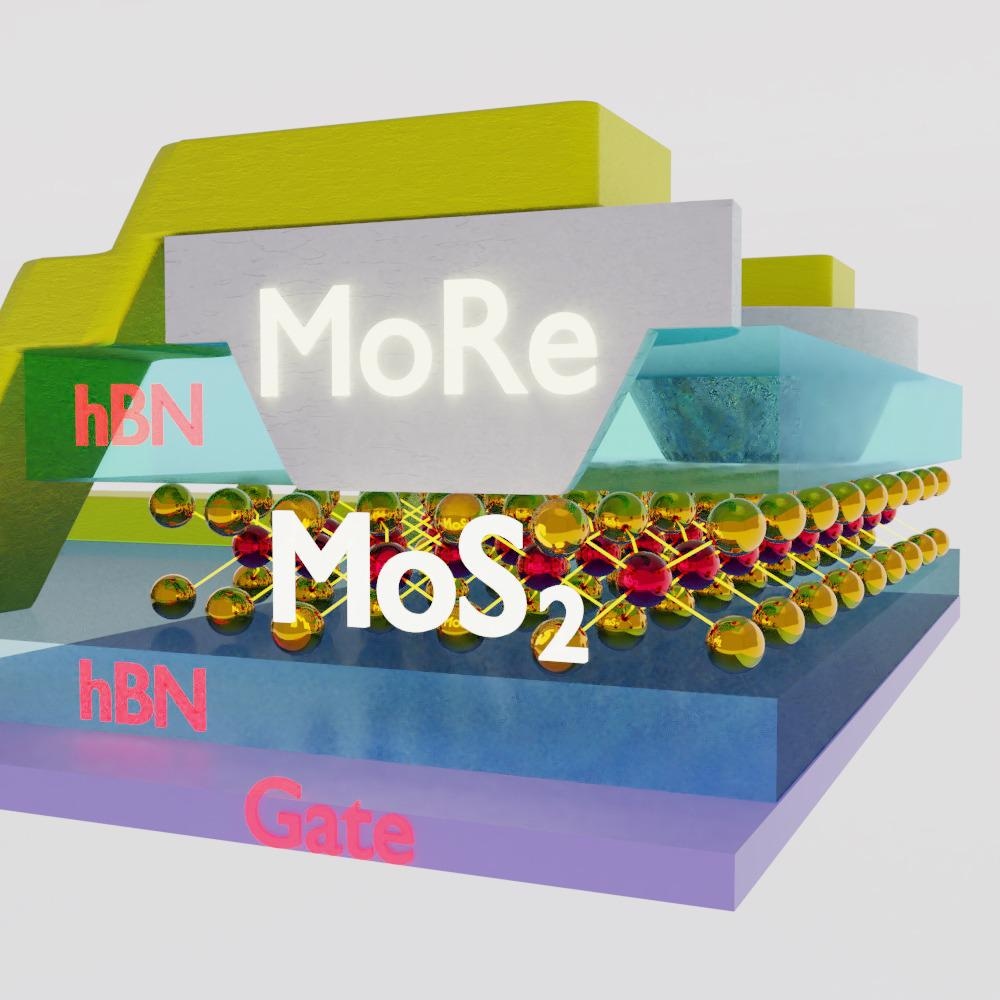Scientists from the University of Basel have fitted superconducting contacts in an ultrathin semiconductor, for the first time.
 The monolayer of molybdenum disulfide (MoS₂) is sandwiched between two protective layers of boron nitride (hBN), with molybdenum rhenium (MoRe) contacts extending through the upper one. A layer of graphene (gate) is used for electrical control. Image Credit: Mehdi Ramezani, Swiss Nanoscience Institute, University of Basel.
The monolayer of molybdenum disulfide (MoS₂) is sandwiched between two protective layers of boron nitride (hBN), with molybdenum rhenium (MoRe) contacts extending through the upper one. A layer of graphene (gate) is used for electrical control. Image Credit: Mehdi Ramezani, Swiss Nanoscience Institute, University of Basel.
Such extremely thin materials with novel optical and electronic properties could set the stage for applications never proposed earlier. In combination with superconductors, these materials are anticipated to pave the way for new quantum phenomena and find use in quantum technology.
Semiconductors play a vital role in electronics whether in televisions, smartphones, or building technology and thus in day-to-day lives. When compared to metals, it is feasible to modify their electrical conductivity through voltage application and therefore to turn the current flow on and off.
Envisioning future applications in electronics and quantum technology, scientists have been making efforts to develop new components that comprise a single layer (monolayer) of semiconducting material.
Certain naturally occurring materials that have semiconducting properties include monolayers of this type, stacked to develop a three-dimensional crystal. In the lab, scientists can isolate such layers — which are not thicker beyond a single molecule — and construct electronic components using these layers.
New Properties and Phenomena
Such ultrathin semiconductors hold promise to provide special characteristics that are otherwise very hard to control, for example, the use of electric fields to control the magnetic moments of electrons. Moreover, intricate quantum mechanical phenomena occur in such semiconducting monolayers that might find applications in quantum technology.
Researchers all over the world have been analyzing how such thin semiconductors can be stacked to develop new synthetic materials called van der Waals heterostructures. But so far, they have not been successful in integrating such a monolayer with superconducting contacts to gain in-depth insights into the unique features and properties of the new materials.
Superconducting Contacts
For the first time, physicists under the guidance of Dr. Andreas Baumgartner working in the research group of Professor Christian Schönenberger at the Swiss Nanoscience Institute and the Department of Physics of the University of Basel have affixed superconducting contacts in a monolayer of the semiconductor molybdenum disulfide.
This blend of superconductor and semiconductor is so fascinating because the experts predict components of this type to display novel properties and physical phenomena.
In a superconductor, the electrons arrange themselves into pairs, like partners in a dance — with weird and wonderful consequences, such as the flow of the electrical current without a resistance.
Dr. Andreas Baumgartner, Study Project Manager, University of Basel
“In the semiconductor molybdenum disulfide, on the other hand, the electrons perform a completely different dance, a strange solo routine that also incorporates their magnetic moments. Now we would like to find out which new and exotic dances the electrons agree upon if we combine these materials,” added Baumgartner.
Suitable for use as a Platform
At the low temperatures needed for superconductivity, which is just above absolute zero (−273.15 °C), the electrical measurements evidently show the effects resulting from the superconductor; for instance, at specific energies, single electrons are no longer permitted.
Furthermore, the scientists discovered signs of a powerful coupling between the semiconductor layer and the superconductor.
“Strong coupling is a key element in the new and exciting physical phenomena that we expect to see in such van der Waals heterostructures, but were never able to demonstrate,” stated Mehdi Ramezani, lead author of the study.
And, of course, we always hope for new applications in electronics and quantum technology. In principle, the vertical contacts we’ve developed for the semiconductor layers can be applied to a large number of semiconductors. Our measurements show that these hybrid monolayer semiconductor components are indeed possible—perhaps even with other, more exotic contact materials that would pave the way for further insights.
Dr. Andreas Baumgartner, Study Project Manager, University of Basel
Ultrathin semiconductors electrically connected to superconductors
Video Credit: University of Basel.
Journal Reference:
Ramezani, M., et al. (2021) Superconducting Contacts to a Monolayer Semiconductor. Nano Letters. doi.org/10.1021/acs.nanolett.1c00615.